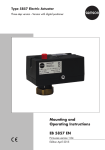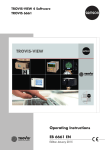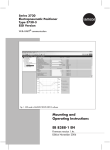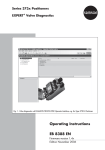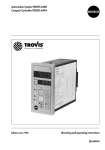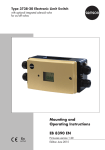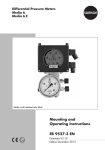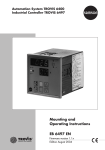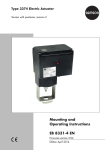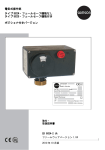Download Mounting and Operating Instructions EB 6610 EN
Transcript
TROVIS 6600 Automation System TROVIS 6610 CPU Module Mounting and Operating Instructions ® Electronics from SAMSON EB 6610 EN Edition June 2010 Definition of signal words DANGER! Hazardous situations which, if not avoided, will result in death or serious injury WARNING! Hazardous situations which, if not avoided, could result in death or serious injury 2 NOTICE Property damage message or malfunction Note: Additional information Tip: Recommended action EB 6610 EN Contents 1 General safety instructions..............................................................................4 2 Overview of the TROVIS 6600 Automation System..........................................5 2.1 System overview.............................................................................................5 2.2 Max. number of units......................................................................................6 2.3 Network expansion (without repeaters, hubs etc.)..............................................7 2.4 Cable recommendation...................................................................................7 2.5 Power supply..................................................................................................7 3 Notes concerning TROVIS 6610 CPU Module...................................................8 3.1 Network settings.............................................................................................8 4 Technical data................................................................................................9 5 Installation...................................................................................................13 5.1 Installation dimensions..................................................................................15 6 Electrical connection.....................................................................................16 6.1 Power line....................................................................................................16 6.2 Scaling of the voltage supply.........................................................................17 6.3 Terminal assignment......................................................................................18 7 Licences.......................................................................................................21 8 BACnet certificates........................................................................................36 Note: The TROVIS 6610 CPU Module is a component from the TROVIS 6600 Automation System. The Application Notes AB 6600 EN describe in detail the system integration of TROVIS 6610 CPU Module together with the other components of the TROVIS 6600 Automation System (TROVIS 6620 I/O Module, TROVIS 6625 Input Module, TROVIS 6615 Web Terminal). These Application Notes are included in the online documentation of TROVIS 6690 Graphical Project Management Tool and are available on request. EB 6610 EN 3 General safety instructions 1 General safety instructions −− The TROVIS 6610 CPU Module is to be mounted, started up or operated only by trained and experienced personnel familiar with the product. According to these mounting and operating instructions, trained personnel refers to individuals who are able to judge the work they are assigned to and recognize possible dangers due to their specialized training, their knowledge and experience as well as their knowledge of the applicable standards. −− The TROVIS 6610 CPU Module has been designed for use in electrical power systems. For wiring and maintenance, you are required to observe the relevant safety regulations. −− Proper shipping and storage are assumed. 4 EB 6610 EN Overview of the TROVIS 6600 Automation System 2 Overview of the TROVIS 6600 Automation System The TROVIS 6600 Automation System consists of self-contained automation stations. These include a TROVIS 6610 CPU Module, TROVIS 6620 I/O Modules, TROVIS 6625 Input Modules and optional TROVIS 6615 Web Terminals. The visualization software usually runs under Microsoft Windows® operating system. A system can process over 20,000 physical data points. The TROVIS 6620 I/O Modules and TROVIS 6625 Input Modules are peripheral devices which communicate with the TROVIS 6610 CPU Module over RS-485. The TROVIS 6610 CPU Modules communicate with each other as well as with the control station over Ethernet (BACnet/IP, BACnet/PTP, TCP/IP or Modbus). The highly flexible modules are suitable for implementing cost-effective solutions. DDC concepts with a high degree of distribution within a network are easy to implement. 2.1 System overview Components in the system Control station TROVIS-LS Operating stations TROVIS-BS CPU module TROVIS 6610 (various models) I/O module TROVIS 6620 (various models) Input module TROVIS 6625 Web terminal TROVIS 6615 Associated software Operating system Usually Windows® Process visualization e.g. Wonderware InTouch Graphical project management tool TROVIS 6690 DA server TROVIS 6691 OPC server TROVIS 6692 Accessories End-of-line termination 1400-9561 (2x included in the scope of delivery) Single-port bus hub 1400-6169 Four-port bus hub 1400-7140 EB 6610 EN 5 Overview of the TROVIS 6600 Automation System Modbus master cable 1400-9748 Modbus slave cable 1400-9749 Serial connecting cable 1400-9750 Cable converter for two-wire circuit 1400-8800 Cable converter for four-wire circuit 1400-7308 Terminals for TROVIS 6610 1991-0133 Terminals for TROVIS 6620 1991-0134 2.2 Max. number of units Modules 32 TROVIS 6610 CPU Modules per system 32 TROVIS 6620 I/O Modules/TROVIS 6625 Input Modules per TROVIS 6610 CPU Module TROVIS 6610 CPU Module 40 physical data points including: 20 universal inputs, which are set individually for each input: −− Analog input: Pt 1000/–40 to 160 °C/0 to 2000 Ω also 0 to 10 V for TROVIS 6610-0001 and higher −− Binary input including channel 1 and 2 as counter inputs up to 1 kHz (1:1) 12 binary outputs · 2 A, 250 V AC (inductive) 8 analog outputs · 0 to 10 V TROVIS 6620 I/O Module 20 physical data points including: 10 universal inputs, which are set individually for each input: −− Analog input: Pt 1000/–40 to 160 °C/0 to 2000 Ω also 0 to 10 V for TROVIS 6620-0001 and higher −− Binary input including channel 1 and 2 as counter inputs up to 1 kHz (1:1) 6 binary outputs · 2 A, 250 V AC (inductive) 4 analog outputs · 0 to 10 V TROVIS 6625 Input Module 20 binary inputs 6 EB 6610 EN Overview of the TROVIS 6600 Automation System 2.3 Network expansion (without repeaters, hubs etc.) Ethernet 100BASE-T typ. LAN I/O bus 1200 m 2.4 Cable recommendation 24 V AC 1.5 mm² stranded wire Ethernet Min. Cat 5 cable, shielded (STP) I/O bus Jy(St) Y 2 x 2 x 0.8 2.5 Power supply 24 V AC, max. 210 VA for −− One TROVIS 6610 CPU Module and −− A total of 32 TROVIS 6620 I/O Modules and/or TROVIS 6625 Input Modules EB 6610 EN 7 Notes concerning TROVIS 6610 CPU Module 3 Notes concerning TROVIS 6610 CPU Module The TROVIS 6610 CPU Module can only be used if it has been integrated into a building automation system to perform its tasks using the TROVIS 6690 Graphical Project Management Tool. In addition, restricted functional operation over a web interface is also possible. The standard IP address necessary to activate the web server is written on the nameplate of the module. SAMSON TROVIS 6610 CPU Module Model no. Serial no. Var.-ID MAC address IP address IO address Power supply: 6610-000x XXXXXXXX XXXXXXX XX:XX:XX:XX:XX:XX XXX.XXX.XXX.XXX XX:XX:XX:XX 24 V AC 50 Hz 15 VA DMC Made in Germany Fig. 1: Nameplate of TROVIS 6610 CPU Module with IP address 3.1 Network settings The TROVIS 6610 CPU Module is delivered without any plant operating software. The MAC address as well as the IP address are written on the left-hand side of the nameplate. The subnet mask is 255.255.0.0. A gateway has not been entered. To change the network settings on a computer, the computer must be in the same subnet as the TROVIS 6610 CPU Module concerned. Example: TROVIS 6610 CPU Module Computer or notebook IP address: 172.30.245.10 172.30..XXX.XXX Subnet mask: 255.255.0.0 255.255.0.0 Gateway: 0.0.0.0 0.0.0.0 8 EB 6610 EN Technical data 4 Technical data Power supply Power supply 24 V AC (20.4 to 27.6 V AC) Frequency range 48 to 62 Hz Power consumption 15 VA Connection 2-pin screw clamp terminal (green) Max. 2.5 mm² wire cross-section Temperature range Operation 0 to 55 °C Transportation and storage –20 to 70 °C Relative humidity Normal, no dew formation Electromagnetic compatibility Noise emission According to EN 61000-6-3 Noise immunity According to EN 61000-6-2 Device safety Class of protection II according to EN 61140: 2003 Overvoltage category II according to EN 60664-1 Degree of contamination 2 according to EN 60664-1 Degree of protection IP 20 according to IEC 60529 Installation Dimensions including terminals (mm) W x H x D: 185 x 130 x 60 Weight Approx. 0.7 kg Mounting On rails (all DIN and EN types) I/O connections Screw clamp terminals Max. 2.5 mm² wire cross-section EB 6610 EN 9 Technical data 20 universal inputs including two counter inputs (channels 1 and 2) Note: There is no galvanic isolation between inputs and to the analog outputs! When used as binary inputs: Power supply to binary inputs Internally powered, approx. 10 V DC Measuring current in short circuit 500 µA Input load Max. 100 Minimum pulse length (1:1) (channels 1 and 2) > 0.5 ms (< 1 kHz) > 500 ms (TROVIS 6610-0001 only) Counter pulse Positive edge triggered Minimum pulse length (channels 3 to 20) 1 s LED on the module for counter inputs ON = Contact made or < 0.4 V OFF = Contact open or > 4 V LED on the module for binary inputs ON = Contact made or < 0.05 V OFF = Contact open or > 1 V When used as analog inputs: Sensor Type of sensor Pt 1000 in two-wire connection Input range –40 to +160 °C Resolution 10 bit Accuracy < 0.5 % of measuring range Temperature influence < 0.1 % of measuring range per 10 K Measuring current 500 µA Resistance Input range 0 to 2000 Ω, two-wire connection Resolution 10 bit Accuracy < 0.1 % of measuring range Temperature influence < 0.05 % of measuring range per 10 K Measuring current 500 µA 10 EB 6610 EN Technical data Voltage (TROVIS 6610-0001 and higher) Input range 0 to 10 V DC Resolution 10 bit Accuracy < 0.5 % of measuring range Temperature influence < 0.04 % of measuring range per 10 K Input resistance 10 kΩ 12 binary outputs Power rating of relay 250 V AC, 2 A inductive load 250 V AC, 3 A resistive load 8 analog outputs Output range 0 to 10 V DC Resolution 10 bit Accuracy < 0.5 % of measuring range Temperature influence < 0.03 % of measuring range per 10 K Permissible load > 3.3 k Short-circuit current 5.5 mA Indication LED status indication EB 6610 EN Binary input and output CPU operation and malfunction Communication (Rx/Tx) for each interface 11 Technical data Interfaces Host level/TROVIS 6610 CPU Module Specification According to IEEE 802.3 Transmission rate 10/100 MBit/s Protocol TCP/IP Connection RJ-45, 8-pole I/O bus Specification RS-485 Two-wire, polarity insensitive Galvanic isolation Yes Transmission rate (kBit/s) 9.6, 19.2, 38.4, 57.6, 115.2 Protocol SAMSON Connection 3-pin screw clamp terminal (green) Max. 2.5 mm² wire cross-section RS-232 Specification RS-232 with RTS/CTS control lines Galvanic isolation No Transmission rate (kBit/s) 9.6, 19.2, 38.4, 57.6, 115.2 Connection RJ-45, 8-pole Modbus Specification RS-485 · Four-wire; two-wire over external jumper Galvanic isolation Yes Transmission rate (kBit/s) 9.6, 19.2, 38.4, 57.6, 115.2 Protocol Modbus RTU (master or slave) Connection RJ-45, 8-pole USB Specification 12 2 x USB 2.0 full speed 12 Mbit/s Memory pen, modem (USB mass storage, USB CDC/ACM) EB 6610 EN Installation 5 Installation ÎÎ Write down the IP address of the TROVIS 6610 CPU Module (nameplate, see Fig. 1 on page 8) before installing it as the IP address will be needed later on during the system integration. Configuration Note: −−In TROVIS 6610-0001, the DIP switches are used to determine how a universal input is to be used. The DIP switches allow the input to be set either as a binary, sensor or resistance input or as a voltage input. −−In older models, the universal input cannot be configured as a voltage input. Therefore, configuration is not required. −−In newer models, the universal inputs are configured in the TROVIS 6690 Graphical Project Management Tool. The DIP switches for module configuration are located at the back of the module. Therefore, the module must be configured first before installation. Each universal input has to be configured separately. The first block of switches configures universal inputs 1 to 10 (labeled correspondingly) while the second block of switches configures universal inputs 11 to 20. The following switch positions apply: −− ON: Configuration of the universal input as a binary, sensor or resistance input −− OFF: Configuration of the universal input as a voltage input Back of CPU module DIP switches for universal inputs UE 1 to 10 11 to 20 Switch position shown UE 1 to 20 = OFF (bottom switch position) Fig. 2: DIP switches on the back of the TROVIS 6610 CPU Module EB 6610 EN 13 Installation Installation The following points apply on installing the module: ÎÎ All modules are equipped with a fixture base for rail mounting TS 35. ÎÎ Keep a minimum distance of 30 mm between the module terminals and the cable duct (see Fig. 3)! ÎÎ As a rule, the modules are installed in a separate instrumentation cabinet. ÎÎ First hook the modules on the top of the rail and press down. Installation directly in the power unit is also possible, provided sufficient shielding is ensured by using a separating metal plate. Cable duct 30 mm 1 2 1 3 2 4 3 5 6 4 7 5 8 9 10 11 12 13 14 15 16 17 18 6 7 8 9 10 19 20 21 22 23 24 25 26 27 28 29 30 11 12 13 14 15 16 1 2 3 4 5 6 17 18 19 A B I/O 20 S 1 2 1 3 2 4 3 5 6 4 7 5 8 9 10 11 12 13 14 15 6 7 8 9 A 10 B S I/O 1 2 1 3 2 4 3 5 6 4 7 5 8 6 9 10 11 12 13 14 15 7 8 9 A 10 B S I/O Ethernet Col RS 232 RS 485 24 31 32 33 34 35 36 1 USB 2 37 38 39 40 41 42 43 44 45 46 47 48 49 50 51 7 8 9 10 11 1 12 52 53 54 55 56 57 58 59 60 24 2 3 4 5 6 16 17 18 19 20 21 22 23 24 25 26 27 28 29 30 1 24 2 3 4 5 6 16 17 18 19 20 21 22 23 24 25 26 27 28 29 30 30 mm Cable duct Fig. 3: Minimum distance to be kept between modules and cable duct (in example shown: one TROVIS 6610 CPU Module and two TROVIS 6620 I/O Modules) Removal ÎÎ Use a screwdriver to lever the latching downwards located underneath the module to detach it from the rail. 14 EB 6610 EN Installation 5.1 Installation dimensions 60 58 130 185 Fig. 4: Installation dimensions of the TROVIS 6610 CPU Module EB 6610 EN 15 Electrical connection 6 Electrical connection 6.1 Power line The TROVIS 6600 Automation System is supplied with a 24 V AC power supply. The voltage supply must be scaled to match the power consumption of all connected modules (see section 6.2). Use two-core wire-end ferrules for the voltage supply wiring to ensure that the other modules remain connected when a module is disconnected from the power supply (see Fig. 5). NOTICE! Damage to the module due incorrect wiring! Do not connect the ground terminals from one module to another module! Tip: SAMSON recommends the use of surge arresters to prevent damage from voltage spikes. 1 2 1 3 2 4 3 5 6 4 7 5 8 9 10 11 12 13 14 15 16 17 18 6 7 8 9 10 19 20 21 22 23 24 25 26 27 28 29 30 11 12 13 14 15 16 1 2 3 4 5 6 17 18 19 A B I/O 20 S 1 2 1 3 2 4 3 5 6 4 7 5 8 9 10 11 12 13 14 15 6 7 8 9 A 10 B S I/O 1 2 1 3 2 4 3 5 6 4 7 5 8 9 10 11 12 13 14 15 6 7 8 9 A 10 B S I/O Ethernet Col RS 232 RS 485 24 31 32 33 34 35 36 1 USB 2 37 38 39 40 41 42 43 44 45 46 47 48 49 50 51 7 8 9 10 11 1 12 52 53 54 55 56 57 58 59 60 24 2 3 4 5 6 16 17 18 19 20 21 22 23 24 25 26 27 28 29 30 1 24 2 3 4 5 6 16 17 18 19 20 21 22 23 24 25 26 27 28 29 30 24VAC ... Fig. 5: Wiring of the supply line for 24 V AC (example shows one TROVIS 6610 CPU Module and two TROVIS 6620 I/O Modules) 16 EB 6610 EN Electrical connection 6.2 Scaling of the voltage supply A maximum of 32 TROVIS 6620 I/O Modules and/or TROVIS 6625 Input Modules can be connected to one TROVIS 6610 CPU Module. The voltage supply of all modules is 24 V AC. Power consumption of single modules Module Voltage Power consumption TROVIS 6610 CPU Module 24 V AC 15 VA TROVIS 6620 I/O Module 24 V AC 6 VA TROVIS 6625 Input Module 24 V DC 8 VA Total power consumption of all connected modules Type TROVIS 6610 CPU Module Qty. Power consumption Total power consumption ... 15 VA ... VA TROVIS 6620 I/O Module ... 6 VA ... VA TROVIS 6625 Input Module … 8 VA … VA Total ... VA 10 % reserve ... VA Total ... VA Voltage drop in the supply line The larger the reduced power from the voltage supply, the larger the drop in voltage or power on the line. The voltage drop is calculated as follows: URL = URL: L: P: κ: A: US: 2×L×P κ × A × US Voltage drop in a two-way circuit [V] One-way circuit length of the supply line [m] Power drawn from the voltage supply [VA] Material constant (kappa); for copper 57 [m/Ω x mm²] Wire cross-section [mm²] Power supply of the system; in this example 24 V EB 6610 EN 17 Electrical connection Recommended power line length for high performances In order to guarantee the power supply of the system, the lower tolerance limit of the transformer as well as the lower tolerance limit of the system must be taken into account. URL × κ × A × Utransformer Lmax = 2×P Lmax: URL: κ: A: Utransformer P: Maximum permissible line length (one-way) Permissible voltage drop (in this example 3.6 V) Material constant (kappa); for copper 57 [m/Ω x mm²] Wire cross-section [mm²] Secondary voltage of the transformer (24 V AC) System’s required power (consuming device) 6.3 Terminal assignment Wiring is connected over screw terminals for a max. 2.5 mm² wire cross-section. Terminal Channel 1 1 2 UE/ZE1 GND 3 2 UE/ZE2 4 3 UE 5 GND 6 4 UE 7 5 UE 8 GND 9 6 UE 10 7 UE 11 GND 12 8 UE 13 9 UE 14 18 Connections of the TROVIS 6610 CPU Module GND 15 10 UE 16 11 UE EB 6610 EN Electrical connection Terminal Channel 17 Connections of the TROVIS 6610 CPU Module GND 18 12 UE 19 13 UE 20 GND 21 14 UE 22 15 UE 23 GND 24 16 UE 25 17 UE 26 GND 27 18 UE 28 19 UE 29 30 GND 20 UE A RX/TX A B RX/TX B S Shielding 24 V AC 24 V AC 15 VA 31 21 32 Power supply AA GND 33 22 AA 34 23 AA 35 GND 36 24 AA 37 25 AA 38 GND 39 26 AA 40 27 AA EB 6610 EN 19 Electrical connection Terminal Channel 41 GND 42 28 AA 43 29 BA 44 Supply of channels 29 and 30 45 30 BA 46 31 BA 47 Supply of channels 31 and 32 48 32 BA 49 33 BA 50 Supply of channels 33 and 34 51 34 BA 52 35 BA 53 Supply of channels 35 and 36 54 36 BA 55 37 BA 56 Supply of channels 37 and 38 57 38 BA 58 39 BA 59 60 20 Connections of the TROVIS 6610 CPU Module Supply of channels 39 and 40 40 BA EB 6610 EN Licences 7 Licences The following listed licenses partly apply to the software technologies and programs used in the TROVIS 6610 CPU Module. The source code of the parts of the TROVIS 6610 firmware which are bound to these licenses can be requested from SAMSON or can be found in the Internet u www.samson.de/support/deser031.htm. GNU GENERAL PUBLIC LICENCE Version 2, June 1991 Copyright (C) 1989, 1991 Free Software Foundation, Inc., 51 Franklin Street, Fifth Floor, Boston, MA 02110-1301 USA Everyone is permitted to copy and distribute verbatim copies of this license document, but changing it is not allowed. Preamble The licenses for most software are designed to take away your freedom to share and change it. By contrast, the GNU General Public License is intended to guarantee your freedom to share and change free software--to make sure the software is free for all its users. This General Public License applies to most of the Free Software Foundation‘s software and to any other program whose authors commit to using it. (Some other Free Software Foundation software is covered by the GNU Lesser General Public License instead.) You can apply it to your programs, too. When we speak of free software, we are referring to freedom, not price. Our General Public Licenses are designed to make sure that you have the freedom to distribute copies of free software (and charge for this service if you wish), that you receive source code or can get it if you want it, that you can change the software or use pieces of it in new free programs; and that you know you can do these things. To protect your rights, we need to make restrictions that forbid anyone to deny you these rights or to ask you to surrender the rights. These restrictions translate to certain responsibilities for you if you distribute copies of the software, or if you modify it. For example, if you distribute copies of such a program, whether gratis or for a fee, you must give the recipients all the rights that you have. You must make sure that they, too, receive or can get the source code. And you must show them these terms so they know their rights. EB 6610 EN 21 Licences We protect your rights with two steps: (1) copyright the software, and (2) offer you this license which gives you legal permission to copy, distribute and/or modify the software. Also, for each author‘s protection and ours, we want to make certain that everyone understands that there is no warranty for this free software. If the software is modified by someone else and passed on, we want its recipients to know that what they have is not the original, so that any problems introduced by others will not reflect on the original authors‘ reputations. Finally, any free program is threatened constantly by software patents. We wish to avoid the danger that redistributors of a free program will individually obtain patent licenses, in effect making the program proprietary. To prevent this, we have made it clear that any patent must be licensed for everyone‘s free use or not licensed at all. The precise terms and conditions for copying, distribution and modification follow. TERMS AND CONDITIONS FOR COPYING, DISTRIBUTION AND MODIFICATION 0. This License applies to any program or other work which contains a notice placed by the copyright holder saying it may be distributed under the terms of this General Public License. The “Program“, below, refers to any such program or work, and a “work based on the Program“ means either the Program or any derivative work under copyright law: that is to say, a work containing the Program or a portion of it, either verbatim or with modifications and/ or translated into another language. (Hereinafter, translation is included without limitation in the term “modification“.) Each licensee is addressed as “you”. Activities other than copying, distribution and modification are not covered by this License; they are outside its scope. The act of running the Program is not restricted, and the output from the Program is covered only if its contents constitute a work based on the Program (independent of having been made by running the Program). Whether that is true depends on what the Program does. 1. You may copy and distribute verbatim copies of the Program‘s source code as you receive it, in any medium, provided that you conspicuously and appropriately publish on each copy an appropriate copyright notice and disclaimer of warranty; keep intact all the notices that refer to this License and to the absence of any warranty; and give any other recipients of the Program a copy of this License along with the Program. You may charge a fee for the physical act of transferring a copy, and you may at your option offer warranty protection in exchange for a fee. 2. You may modify your copy or copies of the Program or any portion of it, thus forming a work based on the Program, and copy and distribute such modifications or work under the terms of Section 1 above, provided that you also meet all of these conditions: 22 EB 6610 EN Licences a) You must cause the modified files to carry prominent notices stating that you changed the files and the date of any change. b) You must cause any work that you distribute or publish, that in whole or in part contains or is derived from the Program or any part thereof, to be licensed as a whole at no charge to all third parties under the terms of this License. c) If the modified program normally reads commands interactively when run, you must cause it, when started running for such interactive use in the most ordinary way, to print or display an announcement including an appropriate copyright notice and a notice that there is no warranty (or else, saying that you provide a warranty) and that users may redistribute the program under these conditions, and telling the user how to view a copy of this License. (Exception: if the Program itself is interactive but does not normally print such an announcement, your work based on the Program is not required to print an announcement.) These requirements apply to the modified work as a whole. If identifiable sections of that work are not derived from the Program, and can be reasonably considered independent and separate works in themselves, then this License, and its terms, do not apply to those sections when you distribute them as separate works. But when you distribute the same sections as part of a whole which is a work based on the Program, the distribution of the whole must be on the terms of this License, whose permissions for other licensees extend to the entire whole, and thus to each and every part regardless of who wrote it. Thus, it is not the intent of this section to claim rights or contest your rights to work written entirely by you; rather, the intent is to exercise the right to control the distribution of derivative or collective works based on the Program. In addition, mere aggregation of another work not based on the Program with the Program (or with a work based on the Program) on a volume of a storage or distribution medium does not bring the other work under the scope of this License. 3. You may copy and distribute the Program (or a work based on it, under Section 2) in object code or executable form under the terms of Sections 1 and 2 above provided that you also do one of the following: a) Accompany it with the complete corresponding machine-readable source code, which must be distributed under the terms of Sections 1 and 2 above on a medium customarily used for software interchange; or, b) Accompany it with a written offer, valid for at least three years, to give any third party, for a charge no more than your cost of physically performing source distribution, a complete machine-readable copy of the corresponding source code, to be distributed under the terms of Sections 1 and 2 above on a medium customarily used for software interchange; or, EB 6610 EN 23 Licences c) Accompany it with the information you received as to the offer to distribute corresponding source code. (This alternative is allowed only for noncommercial distribution and only if you received the program in object code or executable form with such an offer, in accord with Subsection b above.) The source code for a work means the preferred form of the work for making modifications to it. For an executable work, complete source code means all the source code for all modules it contains, plus any associated interface definition files, plus the scripts used to control compilation and installation of the executable. However, as a special exception, the source code distributed need not include anything that is normally distributed (in either source or binary form) with the major components (compiler, kernel, and so on) of the operating system on which the executable runs, unless that component itself accompanies the executable. If distribution of executable or object code is made by offering access to copy from a designated place, then offering equivalent access to copy the source code from the same place counts as distribution of the source code, even though third parties are not compelled to copy the source along with the object code. 4. You may not copy, modify, sublicense, or distribute the Program except as expressly provided under this License. Any attempt otherwise to copy, modify, sublicense or distribute the Program is void, and will automatically terminate your rights under this License. However, parties who have received copies, or rights, from you under this License will not have their licenses terminated so long as such parties remain in full compliance. 5. You are not required to accept this License, since you have not signed it. However, nothing else grants you permission to modify or distribute the Program or its derivative works. These actions are prohibited by law if you do not accept this License. Therefore, by modifying or distributing the Program (or any work based on the Program), you indicate your acceptance of this License to do so, and all its terms and conditions for copying, distributing or modifying the Program or works based on it. 6. Each time you redistribute the Program (or any work based on the Program), the recipient automatically receives a license from the original licensor to copy, distribute or modify the Program subject to these terms and conditions. You may not impose any further restrictions on the recipients‘ exercise of the rights granted herein. You are not responsible for enforcing compliance by third parties to this License. 7. If, as a consequence of a court judgment or allegation of patent infringement or for any other reason (not limited to patent issues), conditions are imposed on you (whether by court order, agreement or otherwise) that contradict the conditions of this License, they do not excuse you from the conditions of this License. If you cannot distribute so as to satisfy simultaneously your obligations under this License and any other pertinent obligations, then as a con- 24 EB 6610 EN Licences sequence you may not distribute the Program at all. For example, if a patent license would not permit royalty-free redistribution of the Program by all those who receive copies directly or indirectly through you, then the only way you could satisfy both it and this License would be to refrain entirely from distribution of the Program. If any portion of this section is held invalid or unenforceable under any particular circumstance, the balance of the section is intended to apply and the section as a whole is intended to apply in other circumstances. It is not the purpose of this section to induce you to infringe any patents or other property right claims or to contest validity of any such claims; this section has the sole purpose of protecting the integrity of the free software distribution system, which is implemented by public license practices. Many people have made generous contributions to the wide range of software distributed through that system in reliance on consistent application of that system; it is up to the author/donor to decide if he or she is willing to distribute software through any other system and a licensee cannot impose that choice. This section is intended to make thoroughly clear what is believed to be a consequence of the rest of this License. 8. If the distribution and/or use of the Program is restricted in certain countries either by patents or by copyrighted interfaces, the original copyright holder who places the Program under this License may add an explicit geographical distribution limitation excluding those countries, so that distribution is permitted only in or among countries not thus excluded. In such case, this License incorporates the limitation as if written in the body of this License. 9. The Free Software Foundation may publish revised and/or new versions of the General Public License from time to time. Such new versions will be similar in spirit to the present version, but may differ in detail to address new problems or concerns. Each version is given a distinguishing version number. If the Program specifies a version number of this License which applies to it and “any later version“, you have the option of following the terms and conditions either of that version or of any later version published by the Free Software Foundation. If the Program does not specify a version number of this License, you may choose any version ever published by the Free Software Foundation. 10. If you wish to incorporate parts of the Program into other free programs whose distribution conditions are different, write to the author to ask for permission. For software which is copyrighted by the Free Software Foundation, write to the Free Software Foundation; we sometimes make exceptions for this. Our decision will be guided by the two goals of preserving the free status of all derivatives of our free software and of promoting the sharing and reuse of software generally. EB 6610 EN 25 Licences NO WARRANTY 11. BECAUSE THE PROGRAM IS LICENSED FREE OF CHARGE, THERE IS NO WARRANTY FOR THE PROGRAM, TO THE EXTENT PERMITTED BY APPLICABLE LAW. EXCEPT WHEN OTHERWISE STATED IN WRITING THE COPYRIGHT HOLDERS AND/OR OTHER PARTIES PROVIDE THE PROGRAM “AS IS“ WITHOUT WARRANTY OF ANY KIND, EITHER EXPRESSED OR IMPLIED, INCLUDING, BUT NOT LIMITED TO, THE IMPLIED WARRANTIES OF MERCHANTABILITY AND FITNESS FOR A PARTICULAR PURPOSE. THE ENTIRE RISK AS TO THE QUALITY AND PERFORMANCE OF THE PROGRAM IS WITH YOU. SHOULD THE PROGRAM PROVE DEFECTIVE, YOU ASSUME THE COST OF ALL NECESSARY SERVICING, REPAIR OR CORRECTION. 12. IN NO EVENT UNLESS REQUIRED BY APPLICABLE LAW OR AGREED TO IN WRITING WILL ANY COPYRIGHT HOLDER, OR ANY OTHER PARTY WHO MAY MODIFY AND/OR REDISTRIBUTE THE PROGRAM AS PERMITTED ABOVE, BE LIABLE TO YOU FOR DAMAGES, INCLUDING ANY GENERAL, SPECIAL, INCIDENTAL OR CONSEQUENTIAL DAMAGES ARISING OUT OF THE USE OR INABILITY TO USE THE PROGRAM (INCLUDING BUT NOT LIMITED TO LOSS OF DATA OR DATA BEING RENDERED INACCURATE OR LOSSES SUSTAINED BY YOU OR THIRD PARTIES OR A FAILURE OF THE PROGRAM TO OPERATE WITH ANY OTHER PROGRAMS), EVEN IF SUCH HOLDER OR OTHER PARTY HAS BEEN ADVISED OF THE POSSIBILITY OF SUCH DAMAGES. END OF TERMS AND CONDITIONS GNU LESSER GENERAL PUBLIC LICENSE Version 2.1, February 1999 Copyright (C) 1991, 1999 Free Software Foundation, Inc., 51 Franklin Street, Fifth Floor, Boston, MA 02110-1301 USA Everyone is permitted to copy and distribute verbatim copies of this license document, but changing it is not allowed. [This is the first released version of the Lesser GPL. It also counts as the successor of the GNU Library Public License, version 2, hence the version number 2.1.] 26 EB 6610 EN Licences Preamble The licenses for most software are designed to take away your freedom to share and change it. By contrast, the GNU General Public Licenses are intended to guarantee your freedom to share and change free software--to make sure the software is free for all its users. This license, the Lesser General Public License, applies to some specially designated software packages--typically libraries--of the Free Software Foundation and other authors who decide to use it. You can use it too, but we suggest you first think carefully about whether this license or the ordinary General Public License is the better strategy to use in any particular case, based on the explanations below. When we speak of free software, we are referring to freedom of use, not price. Our General Public Licenses are designed to make sure that you have the freedom to distribute copies of free software (and charge for this service if you wish); that you receive source code or can get it if you want it; that you can change the software and use pieces of it in new free programs; and that you are informed that you can do these things. To protect your rights, we need to make restrictions that forbid distributors to deny you these rights or to ask you to surrender these rights. These restrictions translate to certain responsibilities for you if you distribute copies of the library or if you modify it. For example, if you distribute copies of the library, whether gratis or for a fee, you must give the recipients all the rights that we gave you. You must make sure that they, too, receive or can get the source code. If you link other code with the library, you must provide complete object files to the recipients, so that they can relink them with the library after making changes to the library and recompiling it. And you must show them these terms so they know their rights. We protect your rights with a two-step method: (1) we copyright the library, and (2) we offer you this license, which gives you legal permission to copy, distribute and/or modify the library. To protect each distributor, we want to make it very clear that there is no warranty for the free library. Also, if the library is modified by someone else and passed on, the recipients should know that what they have is not the original version, so that the original author‘s reputation will not be affected by problems that might be introduced by others. Finally, software patents pose a constant threat to the existence of any free program. We wish to make sure that a company cannot effectively restrict the users of a free program by obtaining a restrictive license from a patent holder. Therefore, we insist that any patent license obtained for a version of the library must be consistent with the full freedom of use specified in this license. EB 6610 EN 27 Licences Most GNU software, including some libraries, is covered by the ordinary GNU General Public License. This license, the GNU Lesser General Public License, applies to certain designated libraries, and is quite different from the ordinary General Public License. We use this license for certain libraries in order to permit linking those libraries into non-free programs. When a program is linked with a library, whether statically or using a shared library, the combination of the two is legally speaking a combined work, a derivative of the original library. The ordinary General Public License therefore permits such linking only if the entire combination fits its criteria of freedom. The Lesser General Public License permits more lax criteria for linking other code with the library. We call this license the “Lesser“ General Public License because it does Less to protect the user‘s freedom than the ordinary General Public License. It also provides other free software developers Less of an advantage over competing non-free programs. These disadvantages are the reason we use the ordinary General Public License for many libraries. However, the Lesser license provides advantages in certain special circumstances. For example, on rare occasions, there may be a special need to encourage the widest possible use of a certain library, so that it becomes a de-facto standard. To achieve this, non-free programs must be allowed to use the library. A more frequent case is that a free library does the same job as widely used non-free libraries. In this case, there is little to gain by limiting the free library to free software only, so we use the Lesser General Public License. In other cases, permission to use a particular library in non-free programs enables a greater number of people to use a large body of free software. For example, permission to use the GNU C Library in non-free programs enables many more people to use the whole GNU operating system, as well as its variant, the GNU/Linux operating system. Although the Lesser General Public License is Less protective of the users‘ freedom, it does ensure that the user of a program that is linked with the Library has the freedom and the wherewithal to run that program using a modified version of the Library. The precise terms and conditions for copying, distribution and modification follow. Pay close attention to the difference between a “work based on the library“ and a “work that uses the library“. The former contains code derived from the library, whereas the latter must be combined with the library in order to run. 28 EB 6610 EN Licences TERMS AND CONDITIONS FOR COPYING, DISTRIBUTION AND MODIFICATION 0. This License Agreement applies to any software library or other program which contains a notice placed by the copyright holder or other authorized party saying it may be distributed under the terms of this Lesser General Public License (also called “this License“). Each licensee is addressed as “you”. A “library“ means a collection of software functions and/or data prepared so as to be conveniently linked with application programs (which use some of those functions and data) to form executables. The “Library“, below, refers to any such software library or work which has been distributed under these terms. A “work based on the Library“ means either the Library or any derivative work under copyright law: that is to say, a work containing the Library or a portion of it, either verbatim or with modifications and/or translated straightforwardly into another language. (Hereinafter, translation is included without limitation in the term “modification“.) “Source code“ for a work means the preferred form of the work for making modifications to it. For a library, complete source code means all the source code for all modules it contains, plus any associated interface definition files, plus the scripts used to control compilation and installation of the library. Activities other than copying, distribution and modification are not covered by this License; they are outside its scope. The act of running a program using the Library is not restricted, and output from such a program is covered only if its contents constitute a work based on the Library (independent of the use of the Library in a tool for writing it). Whether that is true depends on what the Library does and what the program that uses the Library does. 1. You may copy and distribute verbatim copies of the Library‘s complete source code as you receive it, in any medium, provided that you conspicuously and appropriately publish on each copy an appropriate copyright notice and disclaimer of warranty; keep intact all the notices that refer to this License and to the absence of any warranty; and distribute a copy of this License along with the Library. You may charge a fee for the physical act of transferring a copy, and you may at your option offer warranty protection in exchange for a fee. 2. You may modify your copy or copies of the Library or any portion of it, thus forming a work based on the Library, and copy and distribute such modifications or work under the terms of Section 1 above, provided that you also meet all of these conditions: a) The modified work must itself be a software library. b) You must cause the files modified to carry prominent notices stating that you changed the files and the date of any change. EB 6610 EN 29 Licences c) You must cause the whole of the work to be licensed at no charge to all third parties under the terms of this License. d) If a facility in the modified Library refers to a function or a table of data to be supplied by an application program that uses the facility, other than as an argument passed when the facility is invoked, then you must make a good faith effort to ensure that, in the event an application does not supply such function or table, the facility still operates, and performs whatever part of its purpose remains meaningful. (For example, a function in a library to compute square roots has a purpose that is entirely well-defined independent of the application. Therefore, Subsection 2d requires that any application-supplied function or table used by this function must be optional: if the application does not supply it, the square root function must still compute square roots.) These requirements apply to the modified work as a whole. If identifiable sections of that work are not derived from the Library, and can be reasonably considered independent and separate works in themselves, then this License, and its terms, do not apply to those sections when you distribute them as separate works. But when you distribute the same sections as part of a whole which is a work based on the Library, the distribution of the whole must be on the terms of this License, whose permissions for other licensees extend to the entire whole, and thus to each and every part regardless of who wrote it. Thus, it is not the intent of this section to claim rights or contest your rights to work written entirely by you; rather, the intent is to exercise the right to control the distribution of derivative or collective works based on the Library. In addition, mere aggregation of another work not based on the Library with the Library (or with a work based on the Library) on a volume of a storage or distribution medium does not bring the other work under the scope of this License. 3. You may opt to apply the terms of the ordinary GNU General Public License instead of this License to a given copy of the Library. To do this, you must alter all the notices that refer to this License, so that they refer to the ordinary GNU General Public License, version 2, instead of to this License. (If a newer version than version 2 of the ordinary GNU General Public License has appeared, then you can specify that version instead if you wish.) Do not make any other change in these notices. Once this change is made in a given copy, it is irreversible for that copy, so the ordinary GNU General Public License applies to all subsequent copies and derivative works made from that copy. This option is useful when you wish to copy part of the code of the Library into a program that is not a library. 30 EB 6610 EN Licences 4. You may copy and distribute the Library (or a portion or derivative of it, under Section 2) in object code or executable form under the terms of Sections 1 and 2 above provided that you accompany it with the complete corresponding machine-readable source code, which must be distributed under the terms of Sections 1 and 2 above on a medium customarily used for software interchange. If distribution of object code is made by offering access to copy from a designated place, then offering equivalent access to copy the source code from the same place satisfies the requirement to distribute the source code, even though third parties are not compelled to copy the source along with the object code. 5. A program that contains no derivative of any portion of the Library, but is designed to work with the Library by being compiled or linked with it, is called a “work that uses the Library“. Such a work, in isolation, is not a derivative work of the Library, and therefore falls outside the scope of this License. However, linking a “work that uses the Library“ with the Library creates an executable that is a derivative of the Library (because it contains portions of the Library), rather than a “work that uses the library“. The executable is therefore covered by this License. Section 6 states terms for distribution of such executables. When a “work that uses the Library“ uses material from a header file that is part of the Library, the object code for the work may be a derivative work of the Library even though the source code is not. Whether this is true is especially significant if the work can be linked without the Library, or if the work is itself a library. The threshold for this to be true is not precisely defined by law. If such an object file uses only numerical parameters, data structure layouts and accessors, and small macros and small inline functions (ten lines or less in length), then the use of the object file is unrestricted, regardless of whether it is legally a derivative work. (Executables containing this object code plus portions of the Library will still fall under Section 6.) Otherwise, if the work is a derivative of the Library, you may distribute the object code for the work under the terms of Section 6. Any executables containing that work also fall under Section 6, whether or not they are linked directly with the Library itself. 6. As an exception to the Sections above, you may also combine or link a “work that uses the Library“ with the Library to produce a work containing portions of the Library, and distribute that work under terms of your choice, provided that the terms permit modification of the work for the customer‘s own use and reverse engineering for debugging such modifications. You must give prominent notice with each copy of the work that the Library is used in it and that the Library and its use are covered by this License. You must supply a copy of this LiEB 6610 EN 31 Licences cense. If the work during execution displays copyright notices, you must include the copyright notice for the Library among them, as well as a reference directing the user to the copy of this License. Also, you must do one of these things: a) Accompany the work with the complete corresponding machine-readable source code for the Library including whatever changes were used in the work (which must be distributed under Sections 1 and 2 above); and, if the work is an executable linked with the Library, with the complete machine-readable “work that uses the Library“, as object code and/or source code, so that the user can modify the Library and then relink to produce a modified executable containing the modified Library. (It is understood that the user who changes the contents of definitions files in the Library will not necessarily be able to recompile the application to use the modified definitions.) b) Use a suitable shared library mechanism for linking with the Library. A suitable mechanism is one that (1) uses at run time a copy of the library already present on the user‘s computer system, rather than copying library functions into the executable, and (2) will operate properly with a modified version of the library, if the user installs one, as long as the modified version is interface-compatible with the version that the work was made with. c) Accompany the work with a written offer, valid for at least three years, to give the same user the materials specified in Subsection 6a, above, for a charge no more than the cost of performing this distribution. d) If distribution of the work is made by offering access to copy from a designated place, offer equivalent access to copy the above specified materials from the same place. e) Verify that the user has already received a copy of these materials or that you have already sent this user a copy. For an executable, the required form of the “work that uses the Library“ must include any data and utility programs needed for reproducing the executable from it. However, as a special exception, the materials to be distributed need not include anything that is normally distributed (in either source or binary form) with the major components (compiler, kernel, and so on) of the operating system on which the executable runs, unless that component itself accompanies the executable. It may happen that this requirement contradicts the license restrictions of other proprietary libraries that do not normally accompany the operating system. Such a contradiction means you cannot use both them and the Library together in an executable that you distribute. 7. You may place library facilities that are a work based on the Library side-by-side in a single library together with other library facilities not covered by this License, and distribute such a combined library, provided that the separate distribution of the work based on the Li- 32 EB 6610 EN Licences brary and of the other library facilities is otherwise permitted, and provided that you do these two things: a) Accompany the combined library with a copy of the same work based on the Library, uncombined with any other library facilities. This must be distributed under the terms of the Sections above. b) Give prominent notice with the combined library of the fact that part of it is a work based on the Library, and explaining where to find the accompanying uncombined form of the same work. 8. You may not copy, modify, sublicense, link with, or distribute the Library except as expressly provided under this License. Any attempt otherwise to copy, modify, sublicense, link with, or distribute the Library is void, and will automatically terminate your rights under this License. However, parties who have received copies, or rights, from you under this License will not have their licenses terminated so long as such parties remain in full compliance. 9. You are not required to accept this License, since you have not signed it. However, nothing else grants you permission to modify or distribute the Library or its derivative works. These actions are prohibited by law if you do not accept this License. Therefore, by modifying or distributing the Library (or any work based on the Library), you indicate your acceptance of this License to do so, and all its terms and conditions for copying, distributing or modifying the Library or works based on it. 10. Each time you redistribute the Library (or any work based on the Library), the recipient automatically receives a license from the original licensor to copy, distribute, link with or modify the Library subject to these terms and conditions. You may not impose any further restrictions on the recipients‘ exercise of the rights granted herein. You are not responsible for enforcing compliance by third parties with this License. 11. If, as a consequence of a court judgment or allegation of patent infringement or for any other reason (not limited to patent issues), conditions are imposed on you (whether by court order, agreement or otherwise) that contradict the conditions of this License, they do not excuse you from the conditions of this License. If you cannot distribute so as to satisfy simultaneously your obligations under this License and any other pertinent obligations, then as a consequence you may not distribute the Library at all. For example, if a patent license would not permit royalty-free redistribution of the Library by all those who receive copies directly or indirectly through you, then the only way you could satisfy both it and this License would be to refrain entirely from distribution of the Library. If any portion of this section is held invalid or unenforceable under any particular circumstance, the balance of the section is intended to apply, and the section as a whole is intended to apply in other circumstances. EB 6610 EN 33 Licences It is not the purpose of this section to induce you to infringe any patents or other property right claims or to contest validity of any such claims; this section has the sole purpose of protecting the integrity of the free software distribution system which is implemented by public license practices. Many people have made generous contributions to the wide range of software distributed through that system in reliance on consistent application of that system; it is up to the author/donor to decide if he or she is willing to distribute software through any other system and a licensee cannot impose that choice. This section is intended to make thoroughly clear what is believed to be a consequence of the rest of this License. 12. If the distribution and/or use of the Library is restricted in certain countries either by patents or by copyrighted interfaces, the original copyright holder who places the Library under this License may add an explicit geographical distribution limitation excluding those countries, so that distribution is permitted only in or among countries not thus excluded. In such case, this License incorporates the limitation as if written in the body of this License. 13. The Free Software Foundation may publish revised and/or new versions of the Lesser General Public License from time to time. Such new versions will be similar in spirit to the present version, but may differ in detail to address new problems or concerns. Each version is given a distinguishing version number. If the Library specifies a version number of this License which applies to it and “any later version“, you have the option of following the terms and conditions either of that version or of any later version published by the Free Software Foundation. If the Library does not specify a license version number, you may choose any version ever published by the Free Software Foundation. 14. If you wish to incorporate parts of the Library into other free programs whose distribution conditions are incompatible with these, write to the author to ask for permission. For software which is copyrighted by the Free Software Foundation, write to the Free Software Foundation; we sometimes make exceptions for this. Our decision will be guided by the two goals of preserving the free status of all derivatives of our free software and of promoting the sharing and reuse of software generally. 34 EB 6610 EN Licences NO WARRANTY 15. BECAUSE THE LIBRARY IS LICENSED FREE OF CHARGE, THERE IS NO WARRANTY FOR THE LIBRARY, TO THE EXTENT PERMITTED BY APPLICABLE LAW. EXCEPT WHEN OTHERWISE STATED IN WRITING THE COPYRIGHT HOLDERS AND/OR OTHER PARTIES PROVIDE THE LIBRARY “AS IS“ WITHOUT WARRANTY OF ANY KIND, EITHER EXPRESSED OR IMPLIED, INCLUDING, BUT NOT LIMITED TO, THE IMPLIED WARRANTIES OF MERCHANTABILITY AND FITNESS FOR A PARTICULAR PURPOSE. THE ENTIRE RISK AS TO THE QUALITY AND PERFORMANCE OF THE LIBRARY IS WITH YOU. SHOULD THE LIBRARY PROVE DEFECTIVE, YOU ASSUME THE COST OF ALL NECESSARY SERVICING, REPAIR OR CORRECTION. 16. IN NO EVENT UNLESS REQUIRED BY APPLICABLE LAW OR AGREED TO IN WRITING WILL ANY COPYRIGHT HOLDER, OR ANY OTHER PARTY WHO MAY MODIFY AND/OR REDISTRIBUTE THE LIBRARY AS PERMITTED ABOVE, BE LIABLE TO YOU FOR DAMAGES, INCLUDING ANY GENERAL, SPECIAL, INCIDENTAL OR CONSEQUENTIAL DAMAGES ARISING OUT OF THE USE OR INABILITY TO USE THE LIBRARY (INCLUDING BUT NOT LIMITED TO LOSS OF DATA OR DATA BEING RENDERED INACCURATE OR LOSSES SUSTAINED BY YOU OR THIRD PARTIES OR A FAILURE OF THE LIBRARY TO OPERATE WITH ANY OTHER SOFTWARE), EVEN IF SUCH HOLDER OR OTHER PARTY HAS BEEN ADVISED OF THE POSSIBILITY OF SUCH DAMAGES. END OF TERMS AND CONDITIONS EB 6610 EN 35 BACnet certificates 8 BACnet certificates 36 EB 6610 EN BACnet certificates EB 6610 EN 37 BACnet certificates 38 EB 6610 EN BACnet certificates EB 6610 EN 39 Weismüllerstraße 3 · 60314 Frankfurt am Main, Germany Phone: +49 69 4009-0 · Fax: +49 69 4009-1507 [email protected] · www.samson.de EB 6610 EN 2014-07-31 · English SAMSON AG · MESS- UND REGELTECHNIK








































